The recent Batman v Superman movie gets a divided reaction. Some people loved the action and the dark and gritty Batman. Others felt that it wasn’t the characters that they grew up with.
Spider-Man fans are no different. Often, when talking about a particular comic book that was disliked, we hear, “That’s not how Spider-Man acts,” or “That’s not my Spider-Man.” But with a character that has existed over several decades, you start to notice that there are several interpretations of the character. These interpretations are given to us most by writers who have had a considerable run on a Spider-Man title.
When you listen to the podcast *and if you don’t, get to it!), you will hear BD or one of the panelists talk about Peter David’s run on Spider-Man or Howard Mackie’s run or David Michelinie’s run or somebody else. If you are a completist, then you are probably familiar with what they are talking about. However, you may not be able to pull up images in your head for all of these references. If you grew up in the 90s, you may be less familiar with Wolfman’s run or O’Neil’s run. Are you familiar with Kavenaugh’s run? How about DeZago’s? On top of that, several of these writers had several runs on different titles – and often would write differently as they aged.
So what’s a fanboy (or fangirl – not trying to be sexist here) to do? Well, no fear true believers! Compiled below is a list of Spider-Man writers and notable events in their run on the hero.
Already a Marvel zombie? Fill us in on what you feel was left off the list, or not emphasized enough. I envision this as being a fluid resource that we will add to as readers contribute.
‘Nuff said (actually, ‘nuff is not said – you have to click READ MORE)!
Originally, this post was to cover Amazing Spider-Man, Spectacular Spider-Man, and Web of Spider-Man. This turned out to be a much larger project than anticipated. So with that in mind, I am switching the focus. This list is of ASM only – for now. As you look through the list, if you find some vitally important aspect to a writer’s run that was not listed, add it in the comments section. I will take some of those comments and add them to the post. If you guys think that this is a worthwhile undertaking, we will revisit this resource in a few months and add in PPTSM, then later WoSM and adjectiveless. Then we can later even add in mini-series that had huge impacts for good or ill. Put in the comments your opinion of whether or not this should be continued months down the road.
(Also originally the title of the post was ‘Writers Runs’, but as that sounds like an intestinal problem, I changed it.)
O.K., so ground rules for this list. A “run” was defined of at least ten issues in close consecutive order. A “writer” means someone who is listed as writer – not an artist co-plotter.
First we will list who is writing in each decade and then list more information about each writer and his run in alphabetical order by the writer’s last name. An *next to the issue numbers for the run indicates that it was broken by other writers, but most of the issues in the range are by that writer.
BY DECADE
1960s – Stan Lee
1970s – Stan Lee, Conway, Wein, Wolfman
1980s – Wolfman, O’Neil, Stern, DeFalco, Michelinie
1990s – Michelinie, DeMatteis, DeFalco, Mackie
2000s – Mackie, Straczynski, Guggenheim, Slott
2010s – Slott
BY WRITER
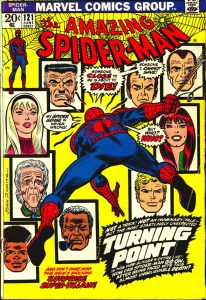 CONWAY, GERRY – Amazing Spider-Man 1972 – 1975 #111-149*
CONWAY, GERRY – Amazing Spider-Man 1972 – 1975 #111-149*
Conway is probably most remembered for killing Gwen Stacy (even Stan Lee jokes about how heartless he is). However, he continued to develop the character in a manner that Stan Lee approved of. He was only 17 years old when he got started in the business and is still writing today (currently on the Carnage series and recently on a point one run on the main title. Conway’s Peter is a hot head, often having angry outbursts and Spidey is definitely street-level.
Villains that first appeared under his pen are Hammerhead, Man-Wolf, the Jackal, the Punisher, the Tarantula, Harry Osborne as the Green Goblin, Mindworm, and the Grizzly (hey, they can’t all be winners).
The supporting cast was developed a bit with the addition of Glory Grant and the relationship between Peter and MJ (they first kiss in issue #143). The original clone saga is in here as well in issues #149 and 150.
We also get the almost wedding of Doc Ock and Aunt May and Spider-Mobile under Conway, but the car may have been by Lee decree.
Conway is listed as #3 on Comics Cube’s top five most important Spider-Man writers list.
CBR lists Conway #3 on their Spider-Man’s top ten writers of all time.
Conway is listed as #6 on Chasing Amazing’s 10 Greatest Spider-Man Writers not Named Lee or Ditko.
Conway is listed as #5 in CBR’s 50 Greatest Spider-Man Creators.
This run is best remembered for the black alien suit. This run is rich in Spider-Man action and Peter Parker development.
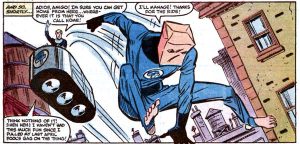 Notable events during this run are the first appearances of The Rose, Black Fox, Puma, Spider-Kid, Normie Osborn, Silver Sable, and Slyde. Also during this run we get the Amazing Bag-Man, Mary Jane’s revelation that she knows Peter’s secret, Spider-Man’s epic battle with Firelord, and the office building turned to gold.
Notable events during this run are the first appearances of The Rose, Black Fox, Puma, Spider-Kid, Normie Osborn, Silver Sable, and Slyde. Also during this run we get the Amazing Bag-Man, Mary Jane’s revelation that she knows Peter’s secret, Spider-Man’s epic battle with Firelord, and the office building turned to gold.
Spider-Man, during DeFalco’s run, is tired, constantly fighting the good fight. Peter Parker’s life is pretty much in shambles because he spends so much time as Spider-Man. This is one of the reasons that many people feel the marriage was rushed, but it is also this run that develops Mary Jane into a complex character whose misfit past fits very well with Peter’s misfit present. DeFalco’s Spider-Man s very street focused, dealing with crime lords more than cosmic or global threats.
DeFalco comes back to ASM almost a decade after he left to finish out the clone saga by writing Ben Reilly as the true Spider-Man. By focusing on Ben Reilly as the real Spider-Man, Spider-Man stories try to recapture the Conway days with Spider-Man working in a coffee shop trying to make ends meet and establishing a life outside of the mask that is constantly interrupted by being Spider-Man. Eventually Peter reclaims the mantle. Mary Jane is pregnant, but the baby ends up being still-born (bur really abducted by Norman Osborn). Doc Ock returns from the dead during this run and it ends with the end of Vol. 1. All in all, the first run is a better take, but DeFalco’s taking over ASM in the 90s gives the core title some much needed stability after Michelinie’s departure.
DEMATTEIS, J. M. – Amazing Spider-Man 1994-1995 #389-406
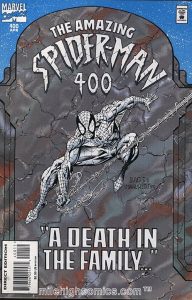 DeMatteis had an earlier run that spread through all titles with his “Kraven’s Last Hunt” story. It was a dark look at the wall crawler that often ends up on Spider-Man’s top stories lists. That was seven years before his run on the main title. DeMatteis wrote several dark and serious Spider-Man stories, exploring areas there that often did not get explored (Peter David paved the way for this on his PPTSSM run).
DeMatteis had an earlier run that spread through all titles with his “Kraven’s Last Hunt” story. It was a dark look at the wall crawler that often ends up on Spider-Man’s top stories lists. That was seven years before his run on the main title. DeMatteis wrote several dark and serious Spider-Man stories, exploring areas there that often did not get explored (Peter David paved the way for this on his PPTSSM run).
DeMatteis run on ASM brings us Stunner and several part arcs, many of which are multi-title crossovers. The run is during the beginning of the clone saga. However, it is remembered for an awesome #400 with the death of Aunt May. It was an amazing death with Aunt May revealing in her last words that she know Peter’s secret identity. It is also a touching moment for Ben Reilly who loves her just as much, but is unable to be with her in her final moments due to being a clone. The issue lost a lot of potency when it was retconned later.
Comics Cube lists DeMatteis as #5 in their top five most important Spider-Man writers list.
CBR lists DeMatteis as #4 on their Spider-Man’s top ten writers of all time.
DeMatteis is listed as #2 on Chasing Amazing’s 10 Greatest Spider-Man Writers not Named Lee or Ditko.
DeMatteis is listed as #4 in CBR’s 50 Greatest Spider-Man Creators.
GUGGENHEIM, MARC – Amazing Spider-Man 2008 – 2009 Various issues in the 500s
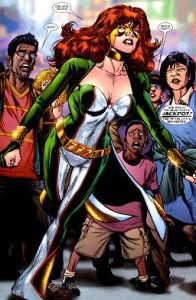 Guggenheim’s run is in small spurts following the events of One More Day. As a result, it is hard to characterize his take on Spidey since he did not have long to establish the character before other writers were brought in for small stints. During his run, Slott, Kelly, Gale, Waid, Stern, Quesada, and Wells all take turns on the title. The attempt during this time is to re-establish Peter Parker as a single bachelor – another attempt to return to the Gerry Conway days.
Guggenheim’s run is in small spurts following the events of One More Day. As a result, it is hard to characterize his take on Spidey since he did not have long to establish the character before other writers were brought in for small stints. During his run, Slott, Kelly, Gale, Waid, Stern, Quesada, and Wells all take turns on the title. The attempt during this time is to re-establish Peter Parker as a single bachelor – another attempt to return to the Gerry Conway days.
Guggenheim does bring in stories dealing with Menace, Jackpot, and an exploration of Ben Reilly.
LEE, STAN – Amazing Spider-Man 1963 – 1972 #1-110*
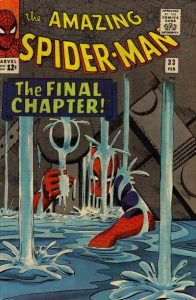 Lee’s run is marked by the artists he co-plotted with. First, you have the pairing with Steve Ditko in which Peter Parker and Spider-Man are generally disliked by those around him. Peter is often angry at the situation he is in and uses Spider-Man as his escape from reality. As Peter, he broods, but as Spider-Man, he quips. Spider-man faces down to earth (if not outlandishly dressed) bad guys and crooks. He’s not protecting the world for the most part, but he is protecting his part of the city. Lee/Ditko’s Spider-Man is definitely is NOT a team player.
Lee’s run is marked by the artists he co-plotted with. First, you have the pairing with Steve Ditko in which Peter Parker and Spider-Man are generally disliked by those around him. Peter is often angry at the situation he is in and uses Spider-Man as his escape from reality. As Peter, he broods, but as Spider-Man, he quips. Spider-man faces down to earth (if not outlandishly dressed) bad guys and crooks. He’s not protecting the world for the most part, but he is protecting his part of the city. Lee/Ditko’s Spider-Man is definitely is NOT a team player.
In this run (the first 38 issues), we get most of Spider-Man’s supporting cast, such as Aunt May, Betty Brant, JJJ, Flash Thompson, Harry Osborn, Norman Osborn, Liz Allan, and even (although faceless) Mary Jane. We also get the first appearance of many of the villains that Spidey will have to face for years to come: the Chameleon, Vulture, Tinkerer, Doctor Octopus, Sandman, Lizard, Living Brain, Electro, the Enforcers, Mysterio, Green Goblin, Kraven the Hunter, Scorpion, the Spider-Slayer, Molten Man, and the Looter. For a large portion of this run, Peter Parker is in high school, but near the end of the Lee/Ditko pairing, he attends college.
Defining issues in this run would be #33 “The Final Chapter” where Spider-Man is trapped under heavy machinery and must push himself past his limits in order to save himself and his Aunt May. It shows the sheer strength of will this hero has in the face of overwhelming odds. This is the run that defines the character.
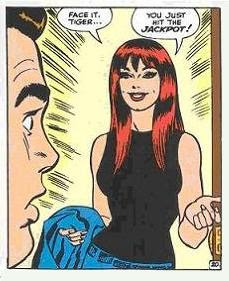 The second part (and much longer) part of his run would be marked by his pairing with John Romita Sr. In this part of the run Spider-Man and Peter Parker are much happier (along with all those around him!). In order to truly appreciate the difference between the feel of the comic book between #38 and #39, you really must treat yourself to a listening of Amazing Spider-Man Classics podcast episode 27. More new villains during this run are the Kingpin, Rhino, Shocker, Prowler, and the Gibbon (who could forget this delightful guy?).
The second part (and much longer) part of his run would be marked by his pairing with John Romita Sr. In this part of the run Spider-Man and Peter Parker are much happier (along with all those around him!). In order to truly appreciate the difference between the feel of the comic book between #38 and #39, you really must treat yourself to a listening of Amazing Spider-Man Classics podcast episode 27. More new villains during this run are the Kingpin, Rhino, Shocker, Prowler, and the Gibbon (who could forget this delightful guy?).
New supporting cast members would be Mary Jane (fully developed) and Joe Robertson. While the Lee/Ditko pairing defined the character, it is the Lee/Romita Sr. pairing that developed the character into the standard that most other runs are compared to.
Notable issues during this run are #42 (just the last page with the first full picture of Mary Jane), #50 “Spider-Man No More”, the death of Captain Stacy in #90, the famous code-less drug issues of #96, 97, and 98, and the six armed Spidey (not drawn by Romita).
Stan Lee is listed as #1 on Comics Cube’s top five most important Spider-Man writers.
CBR lists Lee as #1 on their Spider-Man’s top ten writers of all time.
Lee is listed as #2 and #1 (when paired with Ditko) in CBR’s 50 Greatest Spider-Man Creators.
MACKIE, HOWARD – Amazing Spider-Man 1999-2001 #442-470 (also numbered as Vol. 2 #1-29)
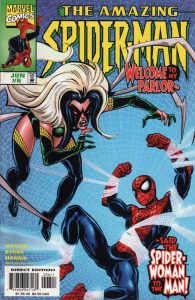 Mackie teamed up with John Byrne to try to “fix” Spider-Man. The Clone Saga failed to bring Spider-Man back to a young swinging single, so this run attempts to force it by having MJ constantly gone and then blown up in a plane. Peter is constantly being either hit on by Jill Stacy or being set up by his supporting cast. Peter is completely broke and struggles to find places to live. There is a lot of Peter Parker in this run, but many felt that all the character development over the past decades had been lost and the attempt to recapture Conway fell short.
Mackie teamed up with John Byrne to try to “fix” Spider-Man. The Clone Saga failed to bring Spider-Man back to a young swinging single, so this run attempts to force it by having MJ constantly gone and then blown up in a plane. Peter is constantly being either hit on by Jill Stacy or being set up by his supporting cast. Peter is completely broke and struggles to find places to live. There is a lot of Peter Parker in this run, but many felt that all the character development over the past decades had been lost and the attempt to recapture Conway fell short.
The stories in Mackie’s run gave us the evil Spider-Woman, Mattie Franklin, Captain Power, and some strange mystical cat that was never finished. The stories largely fell short with fans because of three reasons: 1. the death of Mary Jane and the rush to get Peter dating again, 2. many readers did not like the Gathering of Five, which this run elongates by focusing on the fallout from it, and 3. many readers did not like Byrne’s retelling of Spider-Man’s origin in the Chapter One miniseries, which this run attempts to set into cannon with the Captain Power stories. The run ends with undoing the death of MJ.
Mackie is listed as #22 in CBR’s 50 Greatest Spider-Man Creators.
MICHELINIE, DAVID – Amazing Spider-Man 1987 – 1994 #291-388*
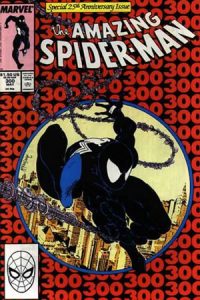 Fortunately and unfortunately for Michelinie, his run is accompanied by three uber-famous artists: McFarlane, Larson, and Bagley. Fortunately for him, because during the ‘90s especially, art was a driving force behind sales. Unfortunately because people often refer to stories in his run by the artist. Michelinie had a good relationship with McFarlane, a rocky relationship with Larsen, and a meh relationship with Bagley, according to interviews.
Fortunately and unfortunately for Michelinie, his run is accompanied by three uber-famous artists: McFarlane, Larson, and Bagley. Fortunately for him, because during the ‘90s especially, art was a driving force behind sales. Unfortunately because people often refer to stories in his run by the artist. Michelinie had a good relationship with McFarlane, a rocky relationship with Larsen, and a meh relationship with Bagley, according to interviews.
Early in his ASM run, Michelinie had much control over the stories he wrote. This gave us stories like Venom, the return of the Sinister Six, and Carnage. There were many events as well, including Assassination, Round Robin, Cosmic Spider-Man, and Trial by Jury. Later in his ASM run, he had a more invasive editorial control, which led to stories like Maximum Carnage, the return of Peter’s parents, and Venom: Lethal Warrior.
While Venom dominates Michelinie’s contribution to the Spider-Man mythos, of equal impact is the marriage of Peter and MJ. Michelinie was given control on how to portray their marriage and he decided to give them a happy marriage. Well, as happy as one can be when one spouse is off risking his life every night. There is a lot of character development with the two. Peter also returns to school in this run.
CBR lists Michelinie as #7 on their Spider-Man’s top ten writers of all time.
Michelinie is listed as #10 in CBR’s 50 Greatest Spider-Man Creators.
O’NEIL, DENNY – Amazing Spider-Man 1980 – 1981 #208-223*
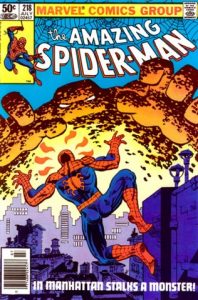 To quote JR Fettinger, “Wolfman left and Denny O’Neil came in and shit all over his unfinished plots.”
To quote JR Fettinger, “Wolfman left and Denny O’Neil came in and shit all over his unfinished plots.”
O’Neil gave us Calisto, Madame Web, and Hydro-Man. Not only did he give us Hydro-Man, but he then had him fight Sandman and have them turn into Mudman. That’s issue #218 and if you’ve never read it, you need to just so you can laugh at how awful it is and at all those chumps in 1981 that spent their hard earned money on it. What O’Neil did do well is bringing in new material for readers by having Spidey fight foes he normally did not fight like the Frightful Four and the Super Apes.
O’Neil is listed as #25 in CBR’s 50 Greatest Spider-Man Creators.
SLOTT, DAN – Amazing Spider-Man 2011-Present #648 through present*
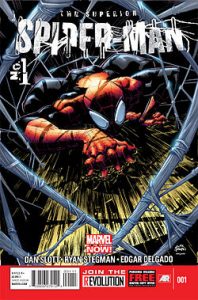 While Slott participated in the broken run on the late 2000s, he really starts his run in 2011 with Big Time and has led the title ever since. Slott’s run is met with either extreme like or extreme dislike. This is because his run focuses on two things.
While Slott participated in the broken run on the late 2000s, he really starts his run in 2011 with Big Time and has led the title ever since. Slott’s run is met with either extreme like or extreme dislike. This is because his run focuses on two things.
The first is major events. During Slott’s run we get several major Spider-related events such as Big Time, Spider-Island, Spider-Verse, and Ends of the Earth. These events lead readers through much hype and either results in both more sales and excitement or reader “event fatigue”.
The second is taking Peter out of typical Peter situations and putting him into unexplored territory. This results in both new and unusual stories and stories that do not always feel like Peter Parker. There is no comparing Slott’s run to Lee, Conway, Stern, or any other – it stands on its own as his take on the character. Slott has such a long run that this take on the character is becoming what being portrayed in other media. This run has seen Peter Parker moving from not making the most of his scientific background, to using it to its full potential. He also has moved from physics and chemistry as his science of choice to making tech. This Spider-Man employs several types of suits, webbing, and vehicles. Slott has also played around with the importance of the powers. Under Slott, the spider-sense has been removed and then heightened then dulled. This character has a strong connection to continuity with several mentions to Spider-Man’s past. Spider-Man’s comic relief changed in this run from Spider-Man making the jokes to Spider-Man being the joke.
What this run will be most remembered for, most likely, is Superior Spider-Man, where Doc Ock took over Peters body and tried to be the better hero.
CBR lists Slott as #5 on their Spider-Man’s top ten writers of all time.
Slott is listed as #3 on Chasing Amazing’s 10 Greatest Spider-Man Writers not Named Lee or Ditko.
Slott is listed as #6 in CBR’s 50 Greatest Spider-Man Creators.
STERN, ROGER – Amazing Spider-Man 1982-1984 #224-252*
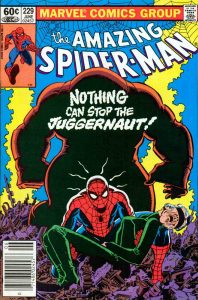 One of my personal favorites. Roger Stern’s run upped the standard for what it means to write Spider-Man. His run boasts stories that often appear in lists of all-time greatest Spider-Man stories. “Nothing Can Stop the Juggernaut” and “The Kid Who Collects Spider-Man” both appear in his run, but he is probably best known for creating the Hobgoblin, which is best remembered by the fact that at the time, the identity was concealed from the reader and people kept writing in with their guesses. Spider-Man here jokes, but is not the butt of the joke. He often made mistakes, but he was not characterized as a loser. Peter was often down on his luck, usually because of something he missed out on while being Spider-Man. He is super idealistic, never backed down, often sarcastic, and very funny. He doesn’t always rely on his science intellect, but he doesn’t display ignorance. Many readers who look at Stern’s run as “their Spider-Man” are often disappointed with the Drake Bell cartoon version and the recent run in the books. This Spidey is a kick butt first and then figure out what was going on. Stern ends his run when Spider-Man returns from Secret Wars.
One of my personal favorites. Roger Stern’s run upped the standard for what it means to write Spider-Man. His run boasts stories that often appear in lists of all-time greatest Spider-Man stories. “Nothing Can Stop the Juggernaut” and “The Kid Who Collects Spider-Man” both appear in his run, but he is probably best known for creating the Hobgoblin, which is best remembered by the fact that at the time, the identity was concealed from the reader and people kept writing in with their guesses. Spider-Man here jokes, but is not the butt of the joke. He often made mistakes, but he was not characterized as a loser. Peter was often down on his luck, usually because of something he missed out on while being Spider-Man. He is super idealistic, never backed down, often sarcastic, and very funny. He doesn’t always rely on his science intellect, but he doesn’t display ignorance. Many readers who look at Stern’s run as “their Spider-Man” are often disappointed with the Drake Bell cartoon version and the recent run in the books. This Spidey is a kick butt first and then figure out what was going on. Stern ends his run when Spider-Man returns from Secret Wars.
Comics Cube lists Stern as #2 on their top five most important Spider-Man writers list.
CBR lists Stern as #2 on their Spider-Man’s top ten writers of all time.
Stern is listed as #1 on Chasing Amazing’s 10 Greatest Spider-Man Writers not Named Lee or Ditko.
Stern is listed as #3 in CBR’s 50 Greatest Spider-Man Creators.
STRACZYNSKI, J. MICHAEL – Amazing Spider-Man 2001-2008 #471-545*
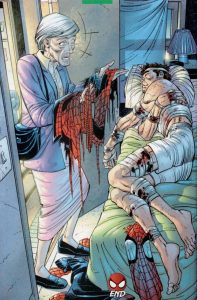 Following the Mackie/Byrne run, JMS set out to pretty much ignore all that went on before and tell his own Spider-Man. Fans typically have mixed views on this run. On the one hand, it is very strong in characterization. Aunt May is never written better than by JMS and her story where she finds out Peter’s secret and deals with it is very realistic (for a word in which superheroes live) and stirring. Peter and MJ rebuild their relationship from the ground up, making them even stronger than they were during the Michelinie run. Peter also follows a new course by becoming a science teacher, a way to keep him mature, yet bring him back to the high school setting. All in all, it is very hard to beat JMS’s ability to develop character. JMS also writes the famous 9/11 issue during this time, which does a good job of capturing the mood of the nation without overplaying the emotion.
Following the Mackie/Byrne run, JMS set out to pretty much ignore all that went on before and tell his own Spider-Man. Fans typically have mixed views on this run. On the one hand, it is very strong in characterization. Aunt May is never written better than by JMS and her story where she finds out Peter’s secret and deals with it is very realistic (for a word in which superheroes live) and stirring. Peter and MJ rebuild their relationship from the ground up, making them even stronger than they were during the Michelinie run. Peter also follows a new course by becoming a science teacher, a way to keep him mature, yet bring him back to the high school setting. All in all, it is very hard to beat JMS’s ability to develop character. JMS also writes the famous 9/11 issue during this time, which does a good job of capturing the mood of the nation without overplaying the emotion.
On the other hand, for all of JMS’s spot on Peter Parker moments, the Spider-Man moments went skewing off in a mystical arena with the introduction of the totem aspect of Spider-Man’s powers. This led to new characters like Morlun, Ezekial, and the Spider-Wasp. Plus he is the one behind Sins Past, which introduced the idea of Gwen getting pregnant with Norman Osborn’s children.
Spider-Man also became a team player by joining the Avengers, just before they split up during Civil War. JMS’s Back in Black arc to end his run remains one of the most brutal Spider-man fights in history as Spider-Man breaks into prison to mercilessly beat up the Kingpin for shooting Aunt May.
All of JMS’s Peter/MJ marriage development is undone when Quesada steps in to write his “One More Day” story.
JMS is listed as #7 on Chasing Amazing’s 10 Greatest Spider-Man Writers not Named Lee or Ditko.
JMS is listed as #9 in CBR’s 50 Greatest Spider-Man Creators.
WEIN, LEN – Amazing Spider-Man 1975-1978 #157-180
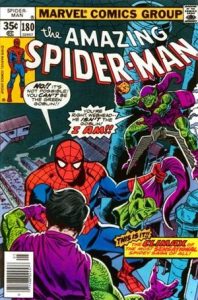 Wein’s Spider-Man, in character, is much like Conway’s (they were roommates, after all); however, in story telling, his adventures are a bit more lack luster (probably due to the page count being dropped to 17 pages an issue during his run). We do get the first appearance of some lower quality villains like Mirage, Will-O’-the-Wisp, Dr. Barton Hamilton (as Green Gobin), and Rocket Racer. New York was a character during this run (and others) since Wein had Spider-Man depicted in actual places found in the city and this firmly grounded Spider-Man as not just a street level hero, but as a New York City street level hero.
Wein’s Spider-Man, in character, is much like Conway’s (they were roommates, after all); however, in story telling, his adventures are a bit more lack luster (probably due to the page count being dropped to 17 pages an issue during his run). We do get the first appearance of some lower quality villains like Mirage, Will-O’-the-Wisp, Dr. Barton Hamilton (as Green Gobin), and Rocket Racer. New York was a character during this run (and others) since Wein had Spider-Man depicted in actual places found in the city and this firmly grounded Spider-Man as not just a street level hero, but as a New York City street level hero.
For some strange reason, Wein thought it was important to bring back the Spider-Mobile after Conway got rid of it. We do get a Green Goblin vs Green Goblin battle as Harry Osborn takes on Hamilton at the end of his run (spoiler alert – Hamilton dies). During his run Harry and Liz get engaged. Jonah falls in love with Marla. And Berryman falls in love with Stegron.
Wein is the last to have the character to himself. Spidey’s popularity begins grow so much that from this point on, there is usually another Spider-Man title on the market.
Wein is listed as #17 in CBR’s 50 Greatest Spider-Man Creators.
WOLFMAN, MARV – Amazing Spider-Man 1978-1980 #182-204
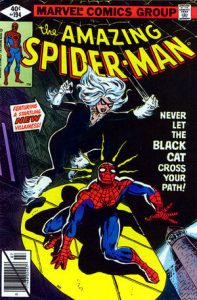 Wolfman pretty much keeps the status quo of who Spider-Man is as developed by Conway and Wein. By that I mean that as Spider-Man. Peter Parker, however, has all sorts of story lines. Peter proposes marriage to MJ, only to be turned down (but as JR said in a podcast once, the fact that he hasn’t even told her his secret shows he isn’t really ready for marriage yet). He shows up for college graduation, only to find out he is a credit short (which he would have known if he had been home to answer his phone and not out web slinging all evening). This run also explores what it would be like for Spidey to be accepted by the public and not hunted by the police, especially issue 184.
Wolfman pretty much keeps the status quo of who Spider-Man is as developed by Conway and Wein. By that I mean that as Spider-Man. Peter Parker, however, has all sorts of story lines. Peter proposes marriage to MJ, only to be turned down (but as JR said in a podcast once, the fact that he hasn’t even told her his secret shows he isn’t really ready for marriage yet). He shows up for college graduation, only to find out he is a credit short (which he would have known if he had been home to answer his phone and not out web slinging all evening). This run also explores what it would be like for Spidey to be accepted by the public and not hunted by the police, especially issue 184.
Betty Brant leaves Ned Leeds during Wolfman’s run and we get mediocre villains like White Dragon and Big Wheel. The biggest contribution to the Spider-Man mythos, however, cannot be overlooked. It is Wolfman who creates the Black Cat. While each issue may not have meant something hue to impact the world, it always seemed to impact Spidey’s personal world.
Wolfman is listed as #15 in CBR’s 50 Greatest Spider-Man Creators.
Buxton, Marc. “Spider-Man’s Top 10 Writers of All Time Wield Power and Responsibility.” CBR. n.p., 17 Dec. 2013. Web. 17 Apr. 2016. <http://www.comicbookresources.com/?page=article&id=49660>.
Cronin, Brian. “50 Greatest Spider-Man Creators Masterlist.” CBR. n.p., 21 May 2012. WEB. 17 Apr. 2016. <http://goodcomics.comicbookresources.com/2012/05/21/50-greatest-spider-man-creators-master-list/>.
Fettinger, J.R. “The Men Who Made Spider-Man.” Spidey Kicks Butt. n.p., 2007. Web. 17 Apr. 2016. <http://www.spideykicksbutt.com/SpiderMan101/SpiderMan101Part5.html>.
Gionnochio, Mark. “10 Greatest Spider-Man Writers not Named Lee or Ditko.” What Culture. n.p., 26 May 2014. Web. 17 Apr. 2016. <http://whatculture.com/superheroes/10-greatest-spider-man-writers-named-stan-lee-steve-ditko?page=1>.
“List of the Amazing Spider-Man Issues.” Wikipedia. Wikimedia, 24 Mar. 2016. Web. 14 Apr. 2016. <https://en.wikipedia.org/wiki/List_of_The_Amazing_Spider-Man_issues>.
Sjoerdsma, Al, and Stuart Vandal. The Amazing Spider-Man: Official Index to the Marvel Universe. New York: Marvel Worldwide, 2010. Print.
“Top Five Most Important Spider-Man Writers of All Time.” Comics Cube. Blogger, 2 July 2010. Web. 17 Apr. 2016. <http://www.comicscube.com/2010/07/top-five-most-important-spider-man.html>.
Images:

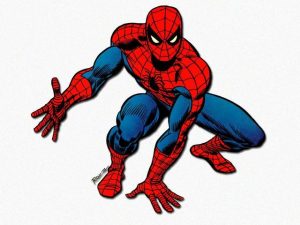

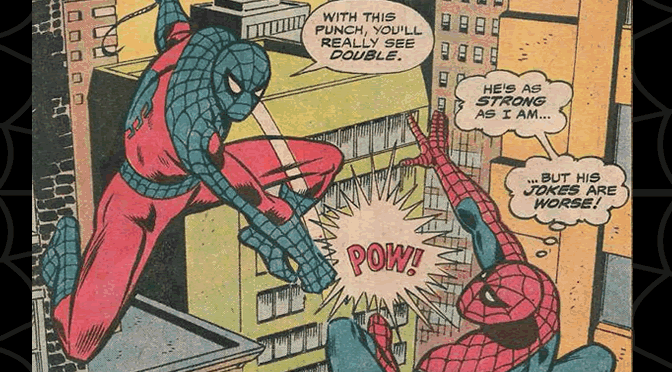
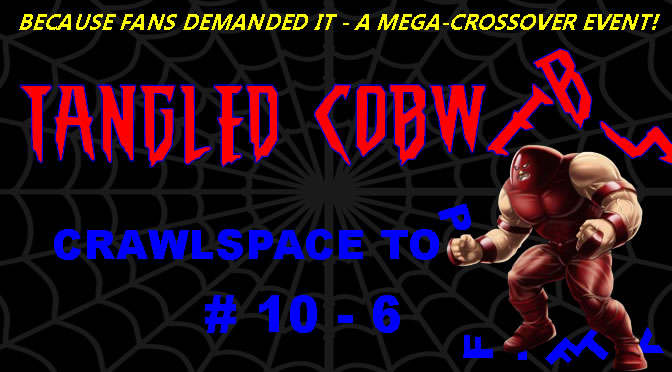





I just read this and Mark knocks it out of the park again. I’m all for more articles reviewing the satellite writers. My Favorites include Stern, Lee, DeFalco, Micheline probably in that order too. You nailed it with the summation of Slott and JMS’s runs. Slott taking Spidey so far from the norm makes him a different character. Also making Spidey the joke feels wrong too. Spidey makes the jokes and doesn’t need a team every issue to help him kick ass. Great article!!!
Spec Spidey cartoon.
100%
Great thread! Honestly, I guess JMS Spidey is my Spidey. It’s when I first started collecting intentionally every month. And even more honestly, nothing post-OMD has really felt like “my” Spider-Man – it’s being written for a new generation (I guess?) and I just kind of casually follow along every month. Doesn’t mean I think all the stories are garbage or anything, it was just such a continuity shift for me that it kinda broke the character. Anybody else feel similarly?
Can’t believe I missed Kingpin! I added him to the post and also mentioned the 9/11 issue.
I didn’t expect this many comments on this post. I’m glad people are enjoying it. In a month or two, I’ll add in Spectacular and Web and later I’ll add in the adjectiveless and some of the off title runs like Marvel Knights and such.
This is a great article and generates so many memories about different eras of following Spider-Man. I agree with an earlier poster that JMS’s 9/11 issue is standout and should be included in the JMS section. Also, the Stan-Romita Sr. era created the Kingpin, who not only was a major player in many stories of that era but remains on the scene today.
#19 — You’re right, I forgot about that whole dinner scene. There goes the one nice thing I was trying to say about Slott’s Spider-Verse story.
When you enumerate Slott’s chronic writing weaknesses (not just the occasional fumble, which every writer has), he no way deserves to be in the top ten, let alone at #5.
1. He has made Spider-Man the joke.
2. He has turned Peter into an impulsive, illogical, immature man-boy.
3. The supporting cast never grows emotionally or relationally.
4. The supporting cast are cartoon caricatures, rather than characters.
5. He is really lazy about plot holes.
6. His plots rely on deus-ex-machinas, absurd conveniences, and contrivances.
7. His Spider-Man is weak and can’t solve problems on his own.
8. He spends so much time setting up the next story that he distracts from the current one.
9. He doesn’t know how to make his adventures hit a climax. They just sort of drain off.
10. He has shown no skill at how to write the romance aspect of Spider-Man.
@#10: This might sound sacriligeous but I actually feel Stan’s run is…weird.
As in I think you should use it as a template kind of loosely. Looking back on it, and this wasn’t confined to Spider-Man at all, Stan, Steve, Jack et al went over the top with the new tricks they’d learned with comic book characters.
Peter has more bad luck than I think he really should have or makes a bigger deal out of it than is warranted, partially because such a concept of a hero capable of experience bad luck was so new that, as with an new innovation, it was overused and abused initially. The egregious use of CGI in films of the mid-1990s until about 2008ish is testament to this. Or even perhaps the way many 1990s comics utilized ‘dark and adult subject matter’ because of Watchmen and TDKR.
Which isn’t to say the stuff is bad because I liked it and I think we all acknowledge it’s ingenuity but I think it did go too far with some things.
At the same time I feel Stan as time went by and he grew older and busier (with lecture tours and the like and probably more editorial responsibility) he sort of began losing a little bit of sight on the character and relying upon crutches in the stories, arguably even flanderizing him. The stuff towards the backend of his run for instance is clearly not as strong as the stuff in the first 50ish issues and kind of repetitive. Case in point: Spider-Man’s girlfriend loses a family member in a battle between Spidey and Doc Ock and holds our hero responsible for it.
Am I talking about Betty Brant and her brother Bennett or Gwen Stacy and her father George?
Of course Stan could still pull things together when it counted. The Drug Trilogy I think is his last truly great Spider-Man story.
“CBR lists Slott as #5 on their Spider-Man’s top ten writers of all time.”
Up to a certain point (GUESS which?!), I simply accept
the Spider-Man I’m given and enjoy the comic.
For me the first 400 issues of ASM are for the most part extremely strong. Sure there are few individual stories that may be weak, but overall the consistency of the series is pretty strong in this run, (sans Denny O’Neil). ASM starts to fray with the advent of the Clone Saga and only recovered during the JMS run. The Lee/Ditko/Romita/Kane run is the strongest by far. It started to lag at the end, so Conway gave it a nice shot in the arm. Conway slips to 4th favorite with Roger Stern as my second favorite and JMS in third. The rest of the Spider-Man runs I put in favorable, OK or unfavorable.
Favorable – Michelinie, DeFalco’s first run, DeMatteis, Wolfman
OK – Wein, Fill in authors – Peter David, Jim Owsley.
Unfavorable – Clone Saga – Incl. DeMatteis, Slott, Guggenheim (Brand New Day “Brain Trust”), Mackie, O’Neal.
I think the most important thing in the article is how current Spider-Man is the butt of the joke, instead of cracking jokes. This is not limited to ASM with Slott, this started with Brand New Day and unfortunately has carried over into other Marvel titles like the Avengers. In addition to toning down the “Parker luck”, I would like to see Spidey rightfully restored in being a valuable team member that cracks jokes, not is the joke.
Jack he didn’t get rid of the cannibalism though. In Spider-Verse, Morlun’s family has a dinner table with limbs, heads, etc. of various Spider-Men. I think one of them was even munching on a limb. Now that may have been a scene in one of the subsidiary books as part of the arc (I honestly cannot remember at this point), but they definitely are still the Donner party of five.
I agree about Dallas Vampires of Southfork (lol). See I think you hit upon Slott’s biggest problem (and this isn’t a Slott bashing fest, he’s done plenty I like (Spider-Island, the Hobgoblin arc, successful, minus the dumb corporation, Peter) and plenty I don’t (love life, making Peter a left-wing crusader, handling of Uncle Ben) is that he’s drawing too much inspiration from the Whedons of the world.
The “it may not be what they (the fans) want, but its what they need” line. The problem is that becomes so self-serving and can apply to any arc that that he feels the fans “need”. He also takes too much CW-style drama and folds it into Spider-Man’s love life. A majority of Slott’s arcs end with something simple (usually a scientific miracle) being done that solves the whole conflict in the arc. This then makes the reader feel like they got cheated after investing.
I remember Conway’s Peter as a lot more cynical and self-pitying than others.
One good thing Slott did with Morlun was Slott got rid of the disgusting cannibalism (remember that JMS had Morlun gouge Peter’s eye out and pop it into his mouth like a grape? Yuck). The rest of the Dallas Vampires of Southfork thing? Not so great. If we were going to have a Morlun at all, I preferred Morlun turn out to be some immortal Victorian-era gentleman.
JMS is probably my favorite. You really get inside of Pete’s head during his run. While I don’t really care for Sins Past, I enjoyed just about everything else that he brought to the table during his run. Grown up, thoughtful Peter was nice. I liked how deep some of the material was. I loved seeing MJ and May become fully fleshed characters. I even loved the mystical connections. JMS’s villains often ended up being external manifestations of the internal struggles of the villain.
It’s amazing how everything since his run has been pretty much destroyed including Morlun. Slott turned Morlun into a cartoonish version of what he was, then decided to add an entire family of Morluns all to service the idea that all the spider-totems of every universe should be involved in a battle royale with Morlun’s family and that the family can clone itself and that they eat spider heads on a dinner table. They became a bunch of universe-hopping vampires who lived in Loomworld or whatever the heck it was called and had a brother who betrayed them and have a big castle. While Morlun certainly had vampiric qualities and the connection was there, JMS never once explicitly referred to Morlun as such. More deeper was the idea that Spider-Man has this great, ancient power carried across time and that there is always an antagonist to this power and the shadowy Morlun was this antagonist. It kind of dilutes the purpose when you create Morlun and Co.
I’d definitely like to see a follow-up with the secondary series writers. Without them we wouldn’t have PAD, Paul Jenkins, Aguirre-Sacasa or most of JMD. (To name a few)
My Spidey would be Stan Lee’s, Tom DeFalco’s, Jenkins’, JMS’, and Slott’s. Mostly because they’re the runs I’ve read all or most of.
I think Spectacular definitely deserves its own article–Mantlo, PAD, DeMatteis’ original extended run, and Conway’s second.
For Mackie, his run on adjectiveless Spider-Man was far better than any of his Amazing Vol. 2 issues.
Perhaps writers on Spec, Web, Sensational, and adjectiveless can be mashed into one future article.
1- 200.
Stan Lee, Ditko, Romita, Andru, Conway, Wein, Wolfman. That’s my Spider-man. Also, issue 200 is a great arc to Peter’s story, as he meets the Burglar again.
The best media translation of Spider-man is the Rock Comix from the 70’s. They nail Spider-man in that.
Also I disagree a lot about Wolfman’s treatment of Peter’s character compared to Conway and Wein. I actually think he regresses Spider-Man a bit and plays up his ‘loser’ status, in particular with his borderline oedipal portrayal of Peter and May’s relationship, Peter’s ooc stupidity over giving May a heart attack, his nonchalance over MJ’s rejection of him and Mysterio kicking his ass. It makes sense given Wolfman’s preference for Ditko over…everyone else.
Also I figured that Peter probably was gonna get around to telling MJ his secret eventually.
My favorite run has to be Stan Lee’s. I love some of the work Dan Slott has done and J. Michael gets high marks in my book for his 9/11 issue alone. But Stan set the tone. Everyone who’s touched the comic sense has really just expanded upon what he created. Another conversation to have is, since Stan worked using the Marvel Method, shouldn’t artists be added to this list at least for the early years? Stan gave them the basic plot, they drew the thing, then Stan came up with the dialogue to fit the drawings. They all share an equal footing with with what Stan’s created in my opinion.
@#4 – This list included on runs on ASM. Roberto Aquerre-Sacasa certainly deserves to be listed as a developer of the character. If everyone wants this list to be expanded, I’ll revisit it in a month or two and add more titles. Eventually we’ll get to Roberto!
@#7 – Thanks! I’ll take praise comments all day long! 🙂
@#8 – Good points on Wein, Mets. I’ve added them into the post. Oh, and I’m a Stern guy too.
@#9 – Correction to the still-born/abduction information made. Thanks!
I judge by the quality of the writing.
Stan Lee is the template, the yardstick by which all else is measured. I don’t find Stan dated at all. Sure, the slang (which Stan made up, anyway) is pure 1960s, and art/dialogue styles have changed. But the situations? Peter torn between his responsibilities as Spider-Man and his personal life? Peter using his resourcefulness to fight villains? The Parker Luck as it is meant to be depicted?
All still very relevant and readable.
J.M. DeMatteis is not on the list, even though DeMatteis had a run on Amazing. His Spider-Man is very hard to beat. DeMatteis told one of the best, if not THE best, Spider-Man stories in Kraven’s Last Hunt. He could write pathos (Death of Aunt May). He could write laugh out loud humor (his White Rabbit stories). He did an amazing, spectacular job with the web of Peter’s and MJ’s marriage, and he never treated MJ as a female shaped doorstop used to prop open the window. His Death of Harry Osborn is another classic story, so unbelievably good in the way DeMatteis works with character, history and continuity and depicts Peter, Harry, MJ and the Green Goblin as all intertwined. Although I respect Sal Buscema for the legend he is, I really, really wish DeMatteis had been teamed with a more “modern,” fan favorite artist – I feel his work has been overlooked because of the art and because he had a long stint in Spectacular instead of Amazing. But he’s one of the best Spidey scribes ever.
I will also willingly re-read Gerry Conway, Mantlo, Wein, Stern, DeFalco’s first run, and JMS.
“DeFalco’s Spider-Man s very street focused, dealing with crime lords more than cosmic or global threats.”
Yes, so DeFalco wrote the character correctly, what of it?????
“Eventually Peter reclaims the mantle. Mary Jane is pregnant, but the baby ends up being still-born, sending Peter on an obsessive bent to find out what really happened…. this run and it ends with the end of Vol. 1. All in all, the first run is a better take, but DeFalco’s taking over ASM in the 90s gives the core title some much needed stability after Michelinie’s departure.”
Some quick corrections here, the baby was abducted by Norman not truly still-born. Additionally Peter was only sent into an obsessive bent to discover the baby’s fate in the Final Chapter arc. Initially he believed the baby had died and mourned her, he didn’t become obsessive.
I’d say DeFalco gave stability to the title in the wake of the Clone controversy not Michelinie’s departure.
And technically DeFalco departed before ASm vol 1 ended. Mackie and Byrne ended volume 1.
I don’t see how people can read DeFalco’s run and see the marriage as rushed. Peter and MJ’s relationship, even discounting Stern and Mantlo’s runs, had been steadily developing since ASM #259 at the very least up until ASM #290. This isn’t even counting the stuff in PPTSS or Web.
I somewhat disagree, because I think you can say that there are certainly things which are in and out of character for Spider-Man. You kind of have to figure it out by reading around enough, but for example something like One More Day is undeniably OOC for Spider-Man. Whilst there isn’t one single perfect Spider-Man, between all the ways the writers write him (and for a long time they did try to be consistent within the context of the times and age of the character at which they were writing him) you can bear out who the character is.
I mean for example maybe we can debate if Spider-Man snapping pix of ladies on street ala the start of Death of Jean DeWolff is something he would or wouldn’t do…but are we really going to say his actions during say Civil War were how he would act in such a situation?
As for MY Spider-Man…I don’t think I have ONE definitive take. Maybe the DeFalco/DeMatteis stuff from the late 1990s but even then I don’t think so.
I feel different writers are better at different aspects of the character. I think DeFalco KNOWS the character the best but he doesn’t delve into the mind and soul of the character as much as DeMatteis did. But DeMatteis pushes the guilt button harder than is warranted for the character, putting it across over the responsiblty idea behind the character. Which is something Michelinie 100% DID understand about the character whatever anyone else says.
I think the 1997 DeMatteis/JMS Spider-Man is perhaps the closest I will ever get to ‘my’ Spider-Man. This isn’t however even getting into different ages of the character. E.g. the Spider-Man I grew up on was the 1994 cartoon version who is awesome and all but that was a 19-22 year old Peter Parker, whereas the character aged beyond that by the 1980s.
A few points on Wein.
Technically, he always shared Spider-Man with the writer of Marvel Team-Up.
One thing that he prided himself on was using New York City landmarks. He’d consistently bring Spider-Man to notable parts of the city, making sure that New York was a major character in the comics. This built on Conway, who had incidentally been his roommate.
I think he was hurt by the reduced page count during his run. 17 pages an issue means that Peter Parker’s private life is going to suffer.
He made sure to give Peter’s supporting cast interesting adventures. Harry hooked up with Liz. Jonah found Marla. Aunt May started protesting discrimination against the elderly. Betty and Ned got married.
These are the articles that make this my favourite Spider-Man site. Keep up everything you are doing Crawlspace and continue to share the history and current developments of this legendary character. Much respect from here in Canada!!
The creators who make up MY Spider-Man are:
Ditko/Lee/Romita Sr
Conway
Stern/Romita Jr/Mantlo/DeMatteis on Team Up
Defalco/Frenz/David/Buckler
DeMatteis/(early Venom/Inferno period)Michelinie/(ASM)McFarlane(ASM)Bagley
JMS/Aguirre-Sacasa/Peter David
Fraction wrote the last story of MY Spider-Man in that Annual.
Then, MY Spidey disappeared
As much as I love JMS on ASM, I don’t think I really consider anything past 1998 canon. “My” Spider-Man was MC2 Peter Parker, the one who got his daughter back, the one who’s Aunt passed away in the brilliant 400th issue, and the man who watched his daughter grow into a hero he could be proud to father and mentor (and no, I don’t consider Spider-Verse canon either)
So yeah, for any fan with common sense, the Spider-Man established and developed by DeFalco is the best choice, because by embracing what he did with the character, you still get to acknowledge and enjoy the runs by so many great writers and artists of the 60s through to the 90s because according to MC2 all of that is canon to it.
Does Roberto Aquerre-Sacasa count as a significant enough contributor?
I think probably a mix of the Spider-Man from the 90’s cartoon, Spectacular, Ultimate Spider-Man comic, and JMS’ run.
I gave this some thought. I think my Spider-Man is Roger Stern’s. This is the best take on a Peter Parker who has been Spider-Man for a few years, which is going to be the case with the majority of Spider-Man comics. The Lee/ Ditko Spider-Man captured a period that can only last for a little while, and is dated in significant ways, even if the material is quite good.
I think Stern also had a fully realized Spider-Man, a guy who has distinct relationships btween different coworkers and classmates, and knows how to be a superhero (he’ll spend time adding webpits to his costume, he’ll try to call the Avengers when fighting Juggernaut, etc.)
My Spider-man is Stan Lee’s. Everyone else’s is a version. 😛
When I started to read Spider-man it was during the Michelinie era, so I’m fond of that era. I can’t defend the quality of the books, but at that time comic books were becoming mainstream with toys, TV shows, video games, and his little thing called the internet. The prices were still reasonable and the art took a quantum leap of awesomeness. Whike his stories were not the best, they were hardly disappointing. But there were better writers, it was just a fond era for me.
JMS also gets my vote.